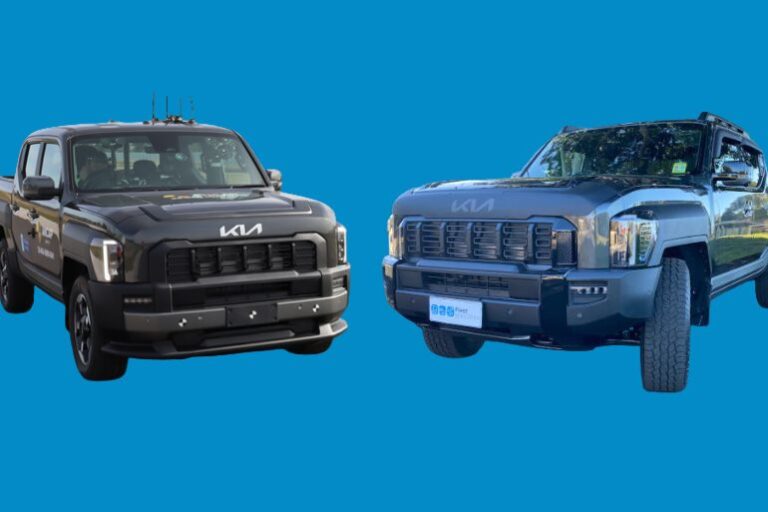The recent five-star ANCAP safety rating for the Kia Tasman should have been a moment of celebration—for Kia, for safety advocates, and for fleet buyers. After all, the Tasman is Kia’s long-awaited entry into the dual-cab ute market, and achieving top marks under the 2023–2025 protocols is no small feat. But rather than putting the safety discussion to rest, this result has opened a new conversation among the fleet community about how ANCAP safety ratings are interpreted and applied in practice.
Five Stars, But Only for Some Variants
The five-star rating applies to specific variants in the Tasman range—namely, the SX and SX+ 4×4 dual cab models equipped with a front bumper design that includes a lower scoop for enhanced protection of vulnerable road users. That’s the vehicle that went through ANCAP’s crash tests. It’s also the variant most likely to be purchased by fleets. So far, so good.
However, this is where things get complicated. Higher-spec variants like the X-Line and X-Pro, which feature a different front-end design more suited to lifestyle buyers and recreational users, have were not tested and are not covered by the five-star rating. Nor are the 4×2, cab chassis, or single cab variants. For Fleet Managers applying a policy that requires all new vehicles to carry a five-star rating, that creates uncertainty. Is the whole Tasman range safe? Or just one slice of it?
The Bull Bar Question
The situation becomes even murkier when you factor in vehicle modifications. Many fleet buyers of 4×4 utes install bull bars as standard—either to protect vehicles in remote conditions or to support operational requirements like mounting winches and communications gear. Yet there’s no indication from ANCAP that vehicles tested with a scoop-equipped bumper would retain their five-star status once that bumper is replaced with a bull bar.
So the announcement poses a question if adding a bull bar—particularly one without specific crash testing—could invalidate the assumptions used in the original safety assessment. This isn’t unique to Kia, but it’s a fundamental weakness in how ANCAP ratings are interpreted in the real world. Vehicles are being tested in one configuration and delivered to fleets in another.
Safety Ratings and Protocol Changes
The Tasman’s five-star result was earned under the latest and toughest protocols—an achievement that stands out when comparing to older ratings. The Toyota Hilux, Ford Ranger and Isuzu D-MAX, for example, were tested under earlier protocols (some as far back as 2019). While they still carry five-star badges, the rules have changed significantly since then. Direct comparisons between ratings from different time periods are increasingly misleading, but ANCAP continues to list them side-by-side in public communications.
This practice clouds the procurement process. A vehicle rated five stars in 2025 is not the same as a five-star vehicle from 2019. Yet fleet procurement policies don’t always reflect that nuance, especially in government and large organisations where procurement checklists demand blanket compliance rather than fit-for-purpose analysis.
Safety Beyond the Stars
The Tasman result should prompt fleet buyers to ask a more important question: Is the current policy of requiring a five-star rating helping or hindering safe vehicle selection?
There’s growing recognition in the fleet industry that a strict ANCAP five-star mandate might be outdated. Vehicles can be exceptionally safe and still fall short of five ANCAP stars—often due to relatively minor issues like the design of the front bumper or the omission of features like a centre airbag or direct driver monitoring. At the same time, some older five-star vehicles would struggle under today’s protocols but are still allowed under legacy policies.
True fleet safety is a multi-dimensional challenge. It includes driver training, trip planning, telematics, pre-start checks, incident response systems, and strong internal policies for managing grey fleet. These are the foundations for vehicles that are a workplace for your employees.
Time for a Policy Reset?
The Kia Tasman’s five-star result, while technically impressive, is also a wake-up call. It highlights the gaps between testing protocols and operational realities. It demonstrates how manufacturers can optimise a specific variant to meet the test criteria, while leaving the rest of the range unrated. And it reveals just how much is left untested—especially when it comes to the accessories and modifications that fleets routinely apply.
This isn’t about criticising ANCAP or manufacturers. It’s about recognising that real-world safety is more complex than a five-star label. For Fleet Managers, the Tasman offers a case study in why it’s time to rethink how safety is defined and measured in procurement decisions.
A five-star ANCAP rating should remain a key input—but it shouldn’t be the only one.






